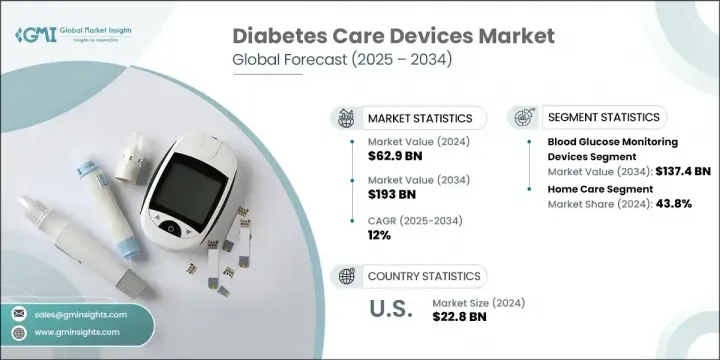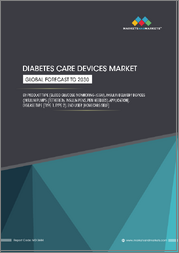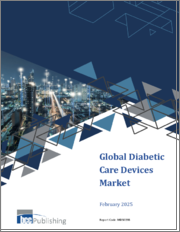
|
시장보고서
상품코드
1801908
당뇨병 치료 기기 시장 : 기회, 성장 촉진요인, 산업 동향 분석, 예측(2025-2034년)Diabetes Care Devices Market Opportunity, Growth Drivers, Industry Trend Analysis, and Forecast 2025 - 2034 |
||||||
세계의 당뇨병 치료 기기 시장은 2024년에는 629억 달러에 달했고, CAGR 12%로 성장하여 2034년에는 1,930억 달러에 이를 것으로 추정됩니다.
이 성장은 세계 당뇨병 부담 증가, 지속적인 기술적 돌파구, 공공 및 민간 부문의 자금 조달 증가에 의해 초래됩니다. 당뇨병 치료 기기는 효과적인 혈당 모니터링과 인슐린 투여를 가능하게 함으로써 당뇨병 관리를 지원하는 의료기기입니다. 당뇨병 환자 수가 세계적으로 증가하고 있는 가운데, 신뢰성이 높고, 사용하기 편리한 케어 기기에 대한 수요는 계속 증가하고 있습니다.

이러한 장비를 보다 침습적이지 않고 보다 정확하고 비용 효율적인 것으로 만드는 데 중점을 둔 기술 혁신이 수요를 촉진하고 있습니다. 기업은 연구개발에 많은 투자를 하고 보다 쾌적하고 질병관리를 확실히 하는 첨단기기를 개발하고 있습니다. 시장은 또한 소비자의 기대에 부응하기 위해 원활한 포도당 추적과 인슐린 전달을 제공하는 보다 스마트한 통합 솔루션으로의 전환을 경험하고 있습니다.
| 시장 범위 | |
|---|---|
| 시작 연도 | 2024년 |
| 예측 연도 | 2025-2034년 |
| 시작 금액 | 629억 달러 |
| 예측 금액 | 1,930억 달러 |
| CAGR | 12% |
2024년 혈당 모니터링 장비 부문은 422억 달러로 평가되었고, 2034년에는 1,374억 달러에 이르고, CAGR 12.7%로 성장할 것으로 예상됩니다. 병원, 진단 실험실 및 재택 관리 설정에서 광범위한 사용이 이러한 성장을 지원합니다. CGM 및 자기 측정 미터와 같은 장치는 지속적인 업데이트를 제공하며 사용자가 실시간 포도당 데이터를 기반으로 라이프 스타일, 식사 섭취량, 인슐린 일정을 조정하는 데 도움이 됩니다. 심각한 건강 문제로 이어질 수 있는 포도당 수치의 급상승과 급강하를 피하기 위해서는 정기적인 모니터링이 필수적입니다. 이 도구는 24시간 시스템에서 피드백을 제공하므로 사용자는 당뇨병 관리를 적극적으로 수행하고 장기적인 합병증을 최소화할 수 있습니다.
홈케어 분야는 2024년 43.8%의 점유율을 차지합니다. 당뇨병을 집에서 관리할 수 있다는 것은 많은 사람들에게 매우 중요한 편의가 되었고, 자주 임상 방문할 필요가 없어졌습니다. 가정용으로 설계된 장비는 현재 전문적인 환경에서 사용되는 것과 유사한 기능을 제공합니다. 실시간 포도당 추세 분석, 알람, 데이터 추적과 같은 고급 기능은 환자가 식단 섭취량, 인슐린 용량, 일상 생활에 대한 빠르고 충분한 정보를 바탕으로 결정을 내리는 데 도움이 됩니다. 재택 당뇨병 관리의 이러한 증가 추세는 자립과 삶의 질 향상을 추구하는 사람들을 매료하고 있습니다.
미국 당뇨병 치료 기기 시장 규모는 2024년 228억 달러가 되었고, 이 호조는 당뇨병 인구 증가와 혁신적인 당뇨병 기술의 급속한 채택으로 인한 것입니다. 만성 질환에 걸리기 쉬운 노화로 인해 효율적인 당뇨병 관리 솔루션에 대한 수요가 더욱 높아지고 있습니다. 이 지역 시장 기세는 하이엔드 건강 관리 인프라 접근, 유리한 상환 시나리오, 예방 의료 및 조기 진단에 대한 소비자의 의식에 의해 지원됩니다.
세계 당뇨병 치료 기기 시장에 영향을 미치는 주요 기업은 Tandem Diabetes Care, Becton, Dickinson and Company, Ypsomed Holding, Insulet, Sanofi, Dr. Reddy's Laboratories, Medtronic, Dexcom, Ascensia Diabetes Care, Sinocare, Platinum Equi Laboratories, ARKRAY, DarioHealth, Eli Lilly and Company, Pendiq, Novo Nordisk, F. Hoffmann-La Roche, Bionime, Nova Biomedical 등이 있습니다. 당뇨병 치료 기기 시장의 선두 기업은 사용자의 진화하는 요구에 대응하기 위해 제품 혁신의 강화와 포트폴리오의 다양화에 주력하고 있습니다. 각 회사는 포도당 추적을 개선하기 위해 실시간 데이터 분석 및 블루투스 연결을 갖춘 스마트 웨어러블 장치를 도입했습니다. 디지털 건강 플랫폼과의 전략적 제휴는 데이터를 보다 광범위한 건강 생태계에 통합하는 데 도움이 됩니다. M&A도 지리적 존재 확대 및 새로운 고객 기반에 대한 액세스에 활용됩니다. R&D에 대한 지속적인 투자로 장비는 침습이 적고 정확하고 사용하기 쉽습니다.
목차
제1장 조사 방법과 범위
제2장 주요 요약
제3장 업계 인사이트
- 생태계 분석
- 공급자의 상황
- 각 단계에서의 부가가치
- 밸류체인에 영향을 주는 요인
- 업계에 미치는 영향요인
- 성장 촉진요인
- 전 세계에서 당뇨병의 이환율이 증가
- 당뇨병 치료 기기에 있어서의 기술 진보의 고조
- 당뇨병 관리에 대한 공적기관 및 민간 조직에 의한 투자 증가
- 업계의 잠재적 위험 및 과제
- 당뇨병 치료 기기의 고비용
- 엄격한 규제 틀
- 시장 기회
- 신흥 시장으로 확대
- 성장 촉진요인
- 성장 가능성 분석
- 규제 상황
- 북미
- 유럽
- 아시아태평양
- 기술적 진보
- 현재의 기술 동향
- 신흥기술
- 공급망과 유통분석
- 상환 시나리오
- 코딩과 상환
- 인슐린 전달 시스템에 대한 상환 정책과 공적 헬스케어 보험의 적용 범위
- 미국
- 유럽
- 가격 분석, 2024
- 장래 시장 동향
- 갭 분석
- Porter's Five Forces 분석
- PESTEL 분석
제4장 경쟁 구도
- 소개
- 기업의 시장 점유율 분석
- 기업 매트릭스 분석
- 주요 시장 기업의 경쟁 분석
- 경쟁 포지셔닝 매트릭스
- 주요 발전
- 합병과 인수
- 파트너십 및 협업
- 신제품 발매
- 확장 계획
제5장 시장 추정 및 예측 : 제품별, 2021년-2034년
- 주요 동향
- 혈당 모니터링 장치
- 자기 혈당 측정기
- 지속 혈당 모니터
- 검사 스트립
- Lancets
- 인슐린 전달 장치
- 인슐린 펌프
- 튜브 펌프
- 튜브리스 펌프
- 펜
- 재사용 가능
- 일회용
- 펜침
- 스탠다드
- 세이프티
- 주사기
- 기타 인슐린 주입 장치
- 인슐린 펌프
제6장 시장 추정 및 예측 : 최종 용도별, 2021년-2034년
- 주요 동향
- 병원
- 외래수술센터(ASC)
- 진단센터
- 홈케어
- 기타 용도
제7장 시장 추정 및 예측 : 국가별, 2021년-2034년
- 주요 동향
- 북미
- 미국
- 캐나다
- 유럽
- 독일
- 프랑스
- 영국
- 이탈리아
- 스페인
- 네덜란드
- 스웨덴
- 벨기에
- 덴마크
- 핀란드
- 노르웨이
- 리투아니아
- 라트비아
- 에스토니아
- 아시아태평양
- 일본
- 중국
- 인도
- 호주
- 한국
- 라틴아메리카
- 브라질
- 멕시코
- 아르헨티나
- 콜롬비아
- 칠레
- 페루
- 중동 및 아프리카
- 남아프리카
- 사우디아라비아
- 아랍에미리트(UAE)
- 튀르키예
- 이집트
- 이스라엘
- 쿠웨이트
- 카타르
제8장 기업 프로파일
- Abbott Laboratories
- ARKRAY
- Ascensia Diabetes Care
- B. Braun Melsungen
- Becton, Dickinson and Company
- Bionime
- DarioHealth
- Dexcom
- Dr. Reddy's Laboratories
- Eli Lilly and Company
- F. Hoffmann-La Roche
- Insulet
- Medtronic
- Nova Biomedical
- Novo Nordisk
- Pendiq
- Platinum Equity Advisors
- Sanofi
- Sinocare
- Tandem Diabetes Care
- Ypsomed Holding
The Global Diabetes Care Devices Market was valued at USD 62.9 billion in 2024 and is estimated to grow at a CAGR of 12% to reach USD 193 billion by 2034. This growth is driven by the rising global diabetes burden, continuous technological breakthroughs, and increased funding from both public and private sectors. Diabetes care devices are essential medical tools that support individuals in managing diabetes by enabling effective blood glucose monitoring and insulin administration. As the number of individuals living with diabetes continues to rise worldwide, the demand for reliable and user-friendly care devices continues to grow.

Innovations focused on making these tools less invasive, more accurate, and cost-effective are propelling demand. Companies are investing heavily in R&D to bring forward advanced devices that ensure better comfort and disease management. The market is also experiencing a shift toward smarter, integrated solutions that provide seamless glucose tracking and insulin delivery to meet growing consumer expectations.
| Market Scope | |
|---|---|
| Start Year | 2024 |
| Forecast Year | 2025-2034 |
| Start Value | $62.9 Billion |
| Forecast Value | $193 Billion |
| CAGR | 12% |
In 2024, the blood glucose monitoring devices segment generated USD 42.2 billion and projected to hit USD 137.4 billion by 2034, growing at a CAGR of 12.7%. Their extensive use in hospitals, diagnostic labs, and homecare setups underpins this growth. Devices like CGMs and self-monitoring meters offer continuous updates, helping users regulate their lifestyle, food intake, and insulin schedules based on real-time glucose data. Regular monitoring is vital to avoid spikes or drops in glucose levels, which can lead to serious health issues. These tools provide round-the-clock feedback, ensuring users remain proactive in their diabetes management and minimizing long-term complications.
The home care segment held 43.8% share in 2024. The ability to manage diabetes at home has become a crucial convenience for many, eliminating the need for frequent clinical visits. Devices designed for home use now offer similar capabilities as those used in professional settings. Advanced features like real-time glucose trend analysis, alarms, and data tracking help patients make quick and informed decisions about food intake, insulin doses, and daily routines. This growing trend of home-based diabetes management continues to attract individuals looking for independence and improved quality of life.
United States Diabetes Care Devices Market generated USD 22.8 billion in 2024. This strong performance is due to the growing diabetic population and the rapid adoption of innovative diabetes technologies. An aging population more prone to chronic conditions further intensifies demand for efficient diabetes management solutions. The market's momentum in the region is supported by access to high-end healthcare infrastructure, favorable reimbursement scenarios, and consumer awareness around preventative care and early diagnosis.
Key companies influencing the Global Diabetes Care Devices Market include Tandem Diabetes Care, Becton, Dickinson and Company, Ypsomed Holding, Insulet, Sanofi, Dr. Reddy's Laboratories, Medtronic, Dexcom, Ascensia Diabetes Care, Sinocare, Platinum Equity Advisors, Abbott Laboratories, ARKRAY, DarioHealth, Eli Lilly and Company, Pendiq, Novo Nordisk, F. Hoffmann-La Roche, Bionime, and Nova Biomedical. Leading players in the diabetes care devices market are focusing on enhancing product innovation and portfolio diversification to meet the evolving needs of users. Companies are introducing smart, wearable devices with real-time data analytics and Bluetooth connectivity to improve glucose tracking. Strategic collaborations with digital health platforms help integrate data into broader health ecosystems. Mergers and acquisitions are also being used to expand geographic presence and access new customer bases. Continuous investments in R&D ensure devices become less invasive, more accurate, and easier to use.
Table of Contents
Chapter 1 Methodology and Scope
- 1.1 Market scope and definition
- 1.2 Research design
- 1.2.1 Research approach
- 1.2.2 Data collection methods
- 1.3 Data mining sources
- 1.3.1 Global
- 1.3.2 Regional/Country
- 1.4 Base estimates and calculations
- 1.4.1 Base year calculation
- 1.4.2 Key trends for market estimation
- 1.5 Primary research and validation
- 1.5.1 Primary sources
- 1.6 Forecast model
- 1.7 Research assumptions and limitations
Chapter 2 Executive Summary
- 2.1 Industry 360° synopsis
- 2.2 Key market trends
- 2.2.1 Regional trends
- 2.2.2 Product trends
- 2.2.3 End use trends
- 2.3 CXO perspectives: Strategic imperatives
- 2.3.1 Key decision points for industry executives
- 2.3.2 Critical success factors for market players
- 2.4 Future outlook and strategic recommendations
Chapter 3 Industry Insights
- 3.1 Industry ecosystem analysis
- 3.1.1 Supplier landscape
- 3.1.2 Value addition at each stage
- 3.1.3 Factor affecting the value chain
- 3.2 Industry impact forces
- 3.2.1 Growth drivers
- 3.2.1.1 Growing prevalence of diabetes across the world
- 3.2.1.2 Rising technological advancements in diabetes care devices
- 3.2.1.3 Increasing investments by public and private organizations for diabetes care
- 3.2.2 Industry pitfalls and challenges
- 3.2.2.1 High cost of diabetes care devices
- 3.2.2.2 Rigorous regulatory framework
- 3.2.3 Market opportunities
- 3.2.3.1 Expansion in emerging markets
- 3.2.1 Growth drivers
- 3.3 Growth potential analysis
- 3.4 Regulatory landscape
- 3.4.1 North America
- 3.4.2 Europe
- 3.4.3 Asia Pacific
- 3.5 Technological advancements
- 3.5.1 Current technological trends
- 3.5.2 Emerging technologies
- 3.6 Supply chain and distribution analysis
- 3.7 Reimbursement scenario
- 3.7.1 Coding and reimbursement
- 3.7.2 Reimbursement policies and public healthcare sector insurance coverage for insulin delivery systems
- 3.7.2.1 U.S.
- 3.7.2.2 Europe
- 3.8 Pricing analysis, 2024
- 3.9 Future market trends
- 3.10 Gap analysis
- 3.11 Porter's analysis
- 3.12 PESTEL analysis
Chapter 4 Competitive Landscape, 2024
- 4.1 Introduction
- 4.2 Company market share analysis
- 4.3 Company matrix analysis
- 4.4 Competitive analysis of major market players
- 4.5 Competitive positioning matrix
- 4.6 Key developments
- 4.6.1 Mergers and acquisitions
- 4.6.2 Partnerships and collaborations
- 4.6.3 New product launches
- 4.6.4 Expansion plans
Chapter 5 Market Estimates and Forecast, By Product, 2021 - 2034 ($ Mn)
- 5.1 Key trends
- 5.2 Blood glucose monitoring devices
- 5.2.1 Self-monitoring blood glucose meters
- 5.2.2 Continuous glucose monitors
- 5.2.3 Testing strips
- 5.2.4 Lancets
- 5.3 Insulin delivery devices
- 5.3.1 Insulin pumps
- 5.3.1.1 Tubed pumps
- 5.3.1.2 Tubeless pumps
- 5.3.2 Pens
- 5.3.2.1 Reusable
- 5.3.2.2 Disposable
- 5.3.3 Pen needles
- 5.3.3.1 Standard
- 5.3.3.2 Safety
- 5.3.4 Syringes
- 5.3.5 Other insulin delivery devices
- 5.3.1 Insulin pumps
Chapter 6 Market Estimates and Forecast, By End Use, 2021 - 2034 ($ Mn)
- 6.1 Key trends
- 6.2 Hospital
- 6.3 Ambulatory surgical centres
- 6.4 Diagnostic centres
- 6.5 Homecare
- 6.6 Other end use
Chapter 7 Market Estimates and Forecast, By Country, 2021 - 2034 ($ Mn)
- 7.1 Key trends
- 7.2 North America
- 7.2.1 U.S.
- 7.2.2 Canada
- 7.3 Europe
- 7.3.1 Germany
- 7.3.2 France
- 7.3.3 UK
- 7.3.4 Italy
- 7.3.5 Spain
- 7.3.6 Netherlands
- 7.3.7 Sweden
- 7.3.8 Belgium
- 7.3.9 Denmark
- 7.3.10 Finland
- 7.3.11 Norway
- 7.3.12 Lithuania
- 7.3.13 Latvia
- 7.3.14 Estonia
- 7.4 Asia Pacific
- 7.4.1 Japan
- 7.4.2 China
- 7.4.3 India
- 7.4.4 Australia
- 7.4.5 South Korea
- 7.5 Latin America
- 7.5.1 Brazil
- 7.5.2 Mexico
- 7.5.3 Argentina
- 7.5.4 Colombia
- 7.5.5 Chile
- 7.5.6 Peru
- 7.6 Middle East and Africa
- 7.6.1 South Africa
- 7.6.2 Saudi Arabia
- 7.6.3 UAE
- 7.6.4 Turkey
- 7.6.5 Egypt
- 7.6.6 Israel
- 7.6.7 Kuwait
- 7.6.8 Qatar
Chapter 8 Company Profiles
- 8.1 Abbott Laboratories
- 8.2 ARKRAY
- 8.3 Ascensia Diabetes Care
- 8.4 B. Braun Melsungen
- 8.5 Becton, Dickinson and Company
- 8.6 Bionime
- 8.7 DarioHealth
- 8.8 Dexcom
- 8.9 Dr. Reddy’s Laboratories
- 8.10 Eli Lilly and Company
- 8.11 F. Hoffmann-La Roche
- 8.12 Insulet
- 8.13 Medtronic
- 8.14 Nova Biomedical
- 8.15 Novo Nordisk
- 8.16 Pendiq
- 8.17 Platinum Equity Advisors
- 8.18 Sanofi
- 8.19 Sinocare
- 8.20 Tandem Diabetes Care
- 8.21 Ypsomed Holding



















